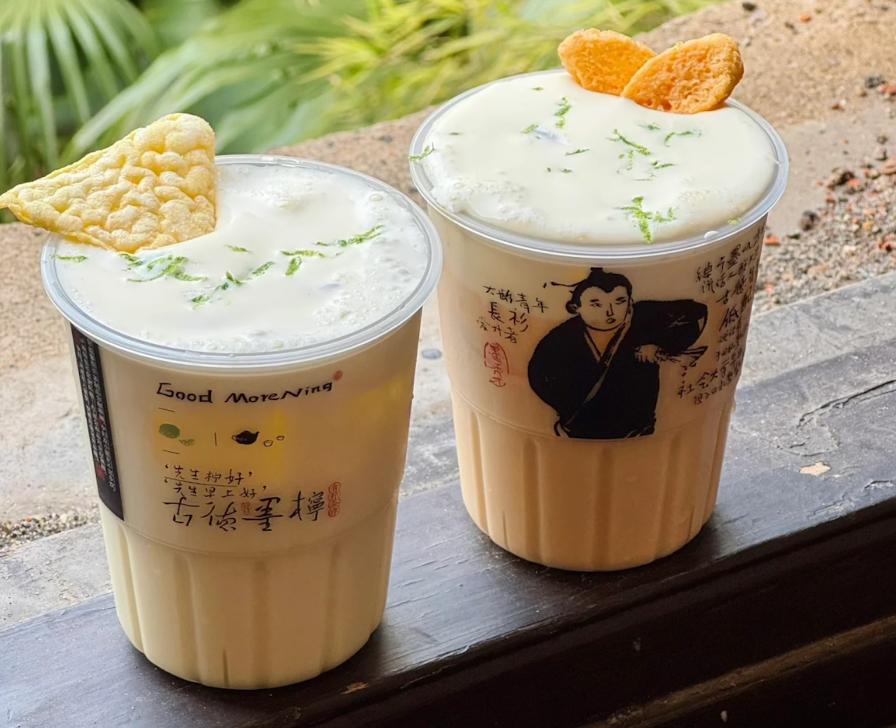
Read More《下半年的爆品是它?蜜雪、沪上阿姨都在押注柠檬奶》
Positive Reviews: The Rise of Lemon Milk – Category Innovation and Technological Breakthroughs Driven by Consumer Demand
In the summer of 2025, “lemon milk” became the most talked – about phenomenon in the tea – beverage industry. From the calls for “put it on the shelves” on social platforms to the rapid follow – up of leading brands like Mixue Bingcheng and Shanghai Aunty; from a regional specialty drink in places like Huzhou, Zhejiang, to the large – scale promotion by national chain brands, the rise of lemon milk is not just the birth of a “blockbuster product”, but also reflects the profound changes in the tea – beverage industry in terms of changing consumer demands, technological breakthroughs, and category innovation.
I. Upgrading of Consumer Demand: Precise Capture from “Sweet and Fragrant” to “Refreshing + Emotional Appeal”
The rise of lemon milk essentially responds precisely to the changing needs of consumers. In recent years, the consumption trend in the tea – beverage market has gradually shifted from “high – sweetness and high – fragrance” to “refreshing and light – burden”. Especially in summer, consumers’ expectations for beverages tend to be more towards “quenching thirst without being greasy and having rich taste layers”. The natural refreshingness of lemon forms a sharp contrast with the mellow taste of milk. It not only retains the silky feeling of dairy drinks but also balances the sweetness and greasiness of traditional milk tea with the sour and sweet taste of lemon, precisely hitting this pain point of consumer demand.
Data from social platforms further confirm this: the number of views of notes related to lemon milk exceeded 9.3 million. The spontaneous behavior of netizens using Mixue Bingcheng products to DIY lemon milk actually reflects consumers’ dual pursuit of “familiarity + novelty” – creating a new taste combination with the well – known lemonade and milk tea bases. This “sense of participation” further amplifies the spread of the category. As Yang Shizhong, the person in charge of product R & D at Baifenccha, said, the rise of lemon milk is “obtaining new taste extensions and emotional satisfaction from familiarity”, which is a typical manifestation of the “emotional value” drive in the current new – consumption era.
II. Technological Breakthrough: Solving the “Flocculation Problem” at the Supply Chain End Paves the Way for Large – Scale Promotion
The key for lemon milk to transform from a regional niche drink to a national one lies in the technological breakthrough at the supply chain end. For a long time, the high acidity of lemon combined with the protein in dairy products has easily led to “flocculation and layering”, which not only affects the taste but also hinders the large – scale promotion of the category. However, this problem was gradually solved in 2025. Brands reduced the probability of flocculation through methods such as precise temperature control, material selection (e.g., pounding the lemon peel to reduce acidic substances), and ratio optimization. At the same time, the supply side launched targeted raw materials, such as Wei Yi’s “acid – resistant thick milk” – fresh real milk that is acid – resistant and retains animal milk fat, which does not flocculate even in hot drinks, completely solving the technological pain point.
Technological breakthroughs make large – scale production of lemon milk possible. Take “Uncle 95’s Lemon Milk” in Ningbo, Zhejiang, as an example. Behind the daily average sales of 600 cups per store is the stable product quality and supply – chain support. The fact that Shanghai Aunty’s “Refreshing Lime Mini Tie” became the second – highest in the repurchase rate of topping milk tea within a week of its launch further verifies consumers’ acceptance of the category after the technology matures.
III. Category Innovation: The Rise of the Fruit – Milk Track Activates New Growth in the Light Milk – Tea Market
The rise of lemon milk is regarded as a signal for the emergence of the “fruit – milk” category. In the past two years, light milk tea has become popular in the market due to its “low – sugar and low – fat” health attributes, but the problem of homogenization has gradually emerged. The formula of combining tea bases like oolong and jasmine with dairy products has made consumers feel tired of it. The emergence of fruit – milk (fruit + dairy) adds fresh fruit elements (such as lemon, yugan, and guava), which not only retains the “light – burden” feature of light milk tea but also creates new memory points with the freshness and flavor layers of fresh fruits, successfully injecting new vitality into the light milk – tea market.
Data shows that the June report of the Kamen Drink Power Laboratory has listed “fruit – flavored light milk tea with fruit + dairy” as a key area for R & D, predicting its large – scale launch. Shanghai Aunty has also clearly stated that it will develop fruit – milk products by combining local specialty fruits (such as yugan in Guangdong and guava in southern Fujian) to create differentiated healthy flavors. This means that lemon milk is not just a short – term hit but may also be the key to promoting the transformation of light milk tea from a “seasonal blockbuster” to an “ever – green category” throughout the year, and to tap more market growth for the industry.
Negative Reviews: Hidden Concerns Behind the Lemon Milk Craze: Challenges of Homogenization and Sustainability
Although the rise of lemon milk has injected new impetus into the tea – beverage industry, there are also risks that cannot be ignored behind this craze. From category characteristics to market competition, from consumer preferences to supply – chain management, the long – term development of lemon milk still needs to overcome multiple challenges.
I. Intensified Homogeneous Competition: The “Blockbuster” May Quickly Become a “Standard Offering”
Currently, the popularity of lemon milk has triggered a “follow – the – trend” among brands. Mixue Bingcheng launched “Snow King Lemon Milk”, Shanghai Aunty launched “Refreshing Lime Mini Tie”, Grandpa Bu Pao Cha launched “Orchid – Scented Lime”, and brands like Good Lemon and Danma Tea House have also followed suit. This “rushing in all at once” phenomenon is very likely to lead lemon milk into a situation of homogeneous competition.
Looking back at the “blockbuster history” of the tea – beverage industry, from cheese milk caps to Yangzhi Ganlu, from juicy grape tea to coconut latte, almost all blockbuster products will eventually lose their differentiated advantages due to brand imitation. If the R & D of lemon milk only stays at the basic formula of “lemon + milk” and lacks in – depth innovation in flavor, process, and scenarios (such as combining local specialty fruits and adding unique toppings), its “novelty” will quickly fade, and it will become a “regular option” on the menu, making it difficult to support long – term growth.
II. Easy “Try – the – New” but Difficult “Repurchase” for Consumers, Questioning the Category’s Lifecycle
The initial rise of lemon milk relies on the “check – in” and “try – the – new” demands on social platforms. Whether it can achieve continuous repurchase depends on whether it has the attributes of a “daily beverage”. Currently, the core selling points of lemon milk are “refreshing + silky”, but consumers’ demands for beverages are diverse. Some people prefer sweetness, some pursue functionality (such as refreshing), and some need a sense of ritual (such as high – value appearance). If lemon milk fails to further explore health (such as low – sugar and high – vitamin C), scenarios (such as breakfast and afternoon tea), or emotional value (such as regional cultural connection) beyond the “basic taste”, its repurchase rate may decline significantly after the “try – the – new” period.
Take the lemon milk specialty stores in Huzhou, Zhejiang, as an example. Although the current daily average sales are 600 cups, the main customer group consists of out – of – town consumers who come specifically for a check – in. It is still unknown whether it can maintain sales through the daily consumption of local consumers after the craze subsides.
III. High Pressure on Supply – Chain Management, Testing the Stability of Quality
The large – scale promotion of lemon milk places higher requirements on the supply chain. On the one hand, the quality of lemons is greatly affected by the place of origin and season. If brands do not establish a stable lemon supply system (such as self – owned planting bases or long – term cooperative orchards), they may face problems such as raw – material price fluctuations and unstable flavors. On the other hand, although acid – resistant dairy products like “acid – resistant thick milk” have solved the flocculation problem, the freshness of dairy raw materials and transportation conditions (such as cold chain) still need to be strictly controlled. Otherwise, it may affect the taste and even cause food – safety problems.
In addition, some brands may choose “fruit – flavored syrup” to replace fresh lemons to reduce costs. This decline in “flavor restoration” will directly affect the consumer experience and damage the category’s reputation. For example, if a brand’s lemon milk has an “abrupt sour taste” or a “weak milk flavor” due to raw – material problems, it may trigger negative evaluations of the entire lemon milk category from consumers.
IV. Potential Health Disputes, Need to Be Alert to the Risk of “Excessive Marketing”
The promotion of lemon milk often emphasizes “refreshing and light – burden”, but whether the combination of dairy and lemon is really “healthy” needs to be objectively evaluated. For example, some lemon milk products add syrup and non – dairy creamer to enhance the taste, and the actual sugar content and calories may not be lower than those of traditional milk tea. The combination of highly acidic lemon and dairy products may cause discomfort to people with sensitive stomachs. If brands over – market the “health” concept while ignoring ingredient transparency and consumer warnings, it may trigger public – opinion disputes and even lead to a trust crisis for the category.
Advice for Entrepreneurs: From “Blockbuster” to “Long – Lasting Success”, Four Key Points to Grasp
The lemon milk craze provides a window for entrepreneurs in category innovation. To achieve the leap from a “short – term blockbuster” to a “long – term category”, entrepreneurs need to focus on the following aspects:
I. Product R & D: Find “Differences” in “Commonalities” to Avoid the Homogenization Trap
Entrepreneurs need to break out of the basic formula of “lemon + milk” and create differentiation through “flavor layering”, “process innovation”, and “scenario binding”. For example, develop “region – limited editions” by combining local specialty fruits (such as wampee in Guangdong and calamansi in Fujian), which can not only enhance uniqueness but also increase emotional value with regional culture. Or highlight the “fresh and refreshing feeling” of lemon through processes like cold – brewing and slow – pounding to distinguish it from the “fruit – flavored syrup” of other brands. They can also launch “high – calcium lemon milk” for the breakfast scenario, adding healthy toppings like oats and chia seeds to enhance functionality.
II. Supply Chain: Establish a Quality Control System from “Source to End”
A stable supply chain is the foundation for the long – term development of lemon milk. Entrepreneurs should give priority to arranging a stable supply of lemon raw materials (such as establishing “direct – purchase lemon bases” in cooperation with production areas) and select reliable dairy suppliers (such as those clearly marked with “100% animal milk fat” and “no non – dairy creamer”). At the same time, they need to optimize cold – chain transportation and in – store storage conditions to ensure the freshness of lemons and the stability of dairy products. In addition, they can introduce “transparent” supply – chain promotion (such as showing the place of origin of raw materials and the production process) to enhance consumer trust.
III. Brand Operation: From “Try – the – New” to “Repurchase”, Strengthen User Stickiness
Entrepreneurs need to break out of the “traffic – thinking” mode and improve user repurchase through “membership systems”, “scenario marketing”, and “emotional connection”. For example, launch a “lemon milk monthly card” for high – frequency consumers, offering discounts or exclusive peripherals. Combine with the “relieve greasiness” scenario in summer and collaborate with light – food and salad brands to launch “refreshing packages”. Or explore the regional cultural attributes of lemon milk (such as the “childhood memory” in Huzhou, Zhejiang) and trigger emotional resonance through storytelling marketing to convert “try – the – new customers” into “loyal customers”.
IV. Long – Term Layout: Use Lemon Milk as a Starting Point to Cultivate the Fruit – Milk Category Ecosystem
The rise of lemon milk is essentially a signal for the emergence of the “fruit – milk” category. Entrepreneurs can take this opportunity to layout a wider range of fruit – milk product lines. For example, launch “spring cherry milk” in spring and “autumn pomelo milk” in autumn according to the seasons, and introduce “Lingnan wampee milk” and “Sichuan – Chongqing loquat milk” according to regions, forming a “fruit – milk family” matrix. At the same time, pay attention to consumers’ demand for a “natural feeling” and emphasize the raw – material label of “fresh fruit + real milk” to distinguish it from “fruit – flavored milk”, promoting the upgrade of fruit – milk from a “blockbuster product” to an “ever – green category”.
In summary, the rise of lemon milk is the result of the combined effects of consumer demand, technological breakthroughs, and category innovation, injecting new vitality into the tea – beverage industry. However, to achieve long – term development, risks such as homogenization, repurchase rate, and supply – chain issues need to be guarded against. For entrepreneurs, the key is to maintain differentiation while following the trend and build long – term value during the period of popularity, transforming the “short – term blockbuster” of lemon milk into the “long – term dividend” of the fruit – milk category.
Latest:
- Startup Commentary”The Incomplete Evolution History of Bathing Centers”
- Startup Commentary”Starting from 358,800 yuan, Maserati Slashes Prices Drastically to Survive”
- Startup Commentary”Monopoly: Always the Best Business”
- Startup Commentary”A PE Giant Spent $6.6 Billion on a Crematorium”
- Startup Commentary”In a Low-Sports Year, Social Assets Still Hold Great Value”





